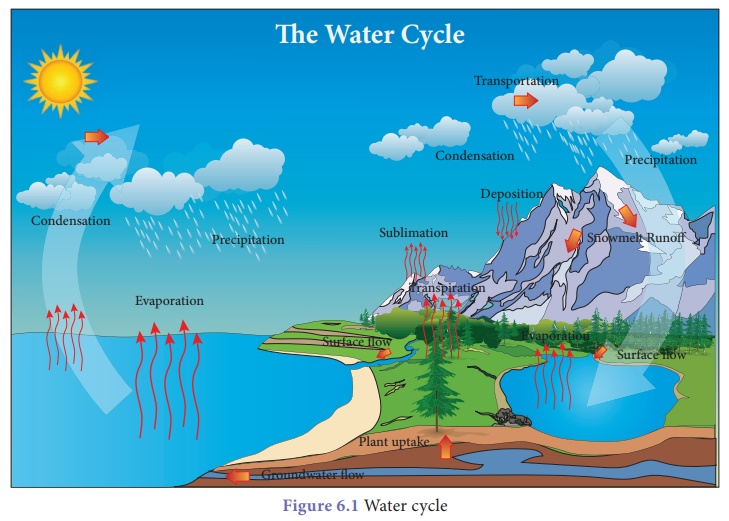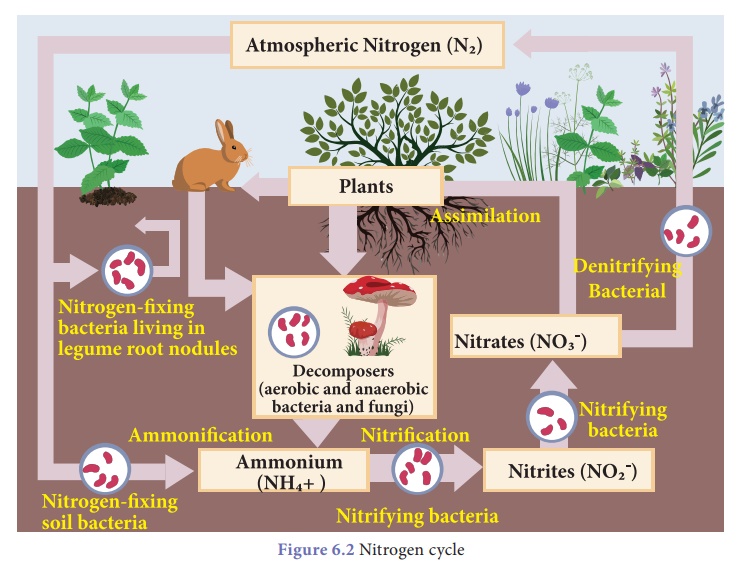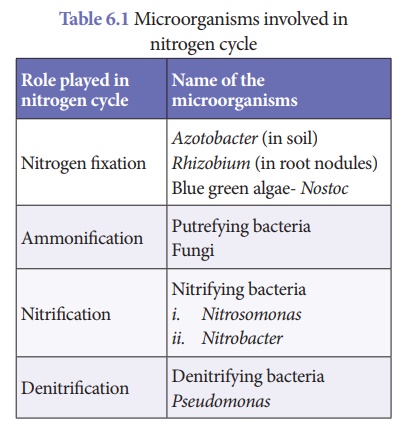Chapter: 9th Science : Environmental Science
Biogeochemical cycles
Biogeochemical cycles (bio – life; geo – earth)
Biosphere is the part of
the earth where life exists. All resources of biosphere can be grouped into two
major categories namely:
(i) Biotic or living factors
which include plants, animals and all other living organisms.
(ii) Abiotic or
non-living factors which include all factors like temperature, pressure, water,
soil, air and sunlight which affect the ability of organisms to survive and
reproduce.
There is a constant
interaction between biotic and abiotic components in the biosphere and that
make the biosphere a dynamic and stable system. Cyclic flow of nutrients
between non-living and living factors of the environment are termed as
biogeochemical cycles. Some of the important biogeochemical cycles are:
1. Water cycle 2. Nitrogen cycle 3. Carbon cycle
1. Water cycle
·
Can you imagine life without water?
·
Have you tried to find out how do we get rain?
·
Why do lakes and ponds dry out during summer?
·
What is the need for conserving and recycling water?
Water cycle has the
answers for all these questions. Water cycle or hydrological cycle is the
continuous movement of water on earth. In this process, water moves from one
reservoir to another, from river to ocean or from ocean to the atmosphere by
processes such as evaporation, sublimation, transpiration, condensation,
precipitation, surface runoff and infiltration, during which water converts
itself to various forms like liquid, solid and vapour (Fig. 6.1). Let's begin
the process of water cycle with evaporation.

Evaporation
Evaporation is a type of vaporization, where liquid is converted to gas before reaching its boiling point. Water evaporates from the surface of the earth and water bodies such as the oceans, seas, lakes, ponds and rivers turn into water vapour.
Sublimation
Sublimation is
conversion of solid to gas, without passing through the intermediate liquid
phase. Ice sheets and ice caps from north and south poles, and icecaps on
mountains, get converted into water vapour directly, without converting into
liquid.
Transpiration
Transpiration is the
process by which plants release water vapour to atmosphere through small pores
in leaves and stems.
Condensation
Condensation is the
changing of gas phase into liquid phase and is the reverse of vaporisation. At
higher altitudes, the temperature is low. The water vapour present there
condenses to form very tiny particles of water droplets. These particles come
close together to form clouds and fog.
Precipitation
Due to change in wind or
temperature, clouds combine to make bigger droplets, and pour down as
precipitation(rain). Precipitation includes drizzle, rain, snow and hail.
Run off
As the water pours down,
it runs over the surface of earth. Runoff water combines to form channels,
rivers, lakes and ends up into seas and oceans.
Infiltration
Some of the precipitated
water moves deep into the soil. Then it moves down and increases the ground
water level.
Percolation
Some of the precipitated
water flows through soil and porous or fractured rock:
Infiltration and
percolation are two related but different processes describing the movement of
water through soil.
Human impacts on water cycle
Major human activities
affecting the water cycle on land are urbanisation, dumping of plastic waste on
land and into water, polluting water bodies and deforestation.
2. Nitrogen cycle
Nitrogen is primary
nutrient important for survival of all living organisms. It is an essential
component of proteins, DNA and chlorophyll. Atmosphere is a rich source of
nitrogen and contains about 78% nitrogen. Plants and animals cannot utilize
atmospheric nitrogen. They can use it only if it is in the form of ammonia,
amino acids or nitrates.
Processes involved in
nitrogen cycle are explained below.

Nitrogen fixation
Nitrogen fixation is the
conversion of atmospheric nitrogen, which is in inert form into reactive
compounds available to living organisms. This conversion is done by a number of
bacteria and blue green algae (Cyanobacteria). Leguminous plants like pea and
beans have a symbiotic relationship with nitrogen fixing bacteria Rhizobium.
Rhizobia occur in the root nodules of leguminous plants and fixes nitrogenous
compounds.
Nitrogen assimilation
Plants absorb nitrate
ions and use them for making organic matter like proteins and nucleic acids.
Herbivorous animals convert plant proteins into animal proteins. Carnivorous
animals synthesize proteins from their food.
Ammonification
The process of
decomposition of nitrogenous waste by putrefying bacteria and fungi into
ammonium compounds is called ammonification. Animal proteins are excreted in
the form of urea, uric acid or ammonia. The putrefying bacteria and fungi
decompose these animal proteins, dead animals and plants into ammonium
compounds.
Nitrification
The ammonium compounds
formed by ammonification process are oxidised to soluble nitrates. This process
of nitrate formation is known as nitrification. The bacteria responsible for
nitrification are called as nitrifying bacteria.
Denitrification
Free living soil
bacteria such as Pseudomonas sp. reduce nitrate ions of soil into
gaseous nitrogen which enters the atmosphere.
Human impacts on nitrogen cycle
Burning fossil fuels,
application of nitrogen-based fertilizers and other activities can increase the
amount of biologically available nitrogen in an ecosystem. Nitrogen applied to
agricultural fields enters rivers and marine systems. It alters the
biodiversity, changes the food web structure and destroys the general habitat.

3. Carbon cycle
Carbon occurs in various
forms on earth. Charcoal, diamond and graphite are elemental forms of carbon.
Combined forms of carbon include carbon monoxide, carbon dioxide and carbonate
salts. All living organisms are made up of carbon containing molecules like
proteins and nucleic acids. The atmospheric carbon dioxide enters into the
plants through the process of photosynthesis to form carbohydrates. From
plants, it is passed on to herbivores and carnivores. During respiration,
plants and animals release carbon into atmosphere in the form of carbon
dioxide. Carbon dioxide is also returned to the atmosphere through
decomposition of dead organic matter, burning fossil fuels and volcanic
activities.

Human impacts on carbon cycle
More carbon moves into
the atmosphere due to burning of fossil fuels and deforestation. Most of the
carbon in atmosphere is in the form of carbon dioxide. Carbon dioxide is a
greenhouse gas. By increasing the amount of carbon dioxide, earth becomes
warmer. This leads to greenhouse effect and global warming.
It is really interesting
to know how nature renews itself. At the same time, it also reminds us of our
responsibility to reduce and restrain our activities that will affect the
natural processes. Living organisms also try to adjust themselves according to
their habitat and changes in the ecosystems. The adaptations help them to
survive better.
Related Topics